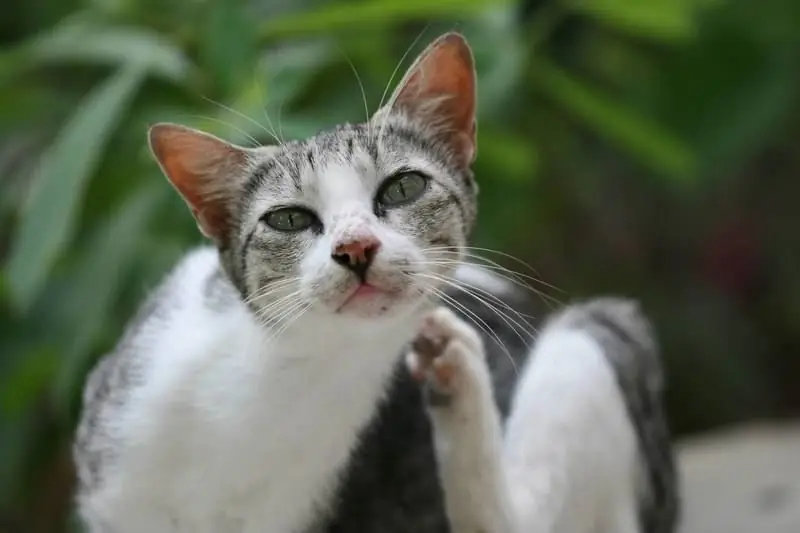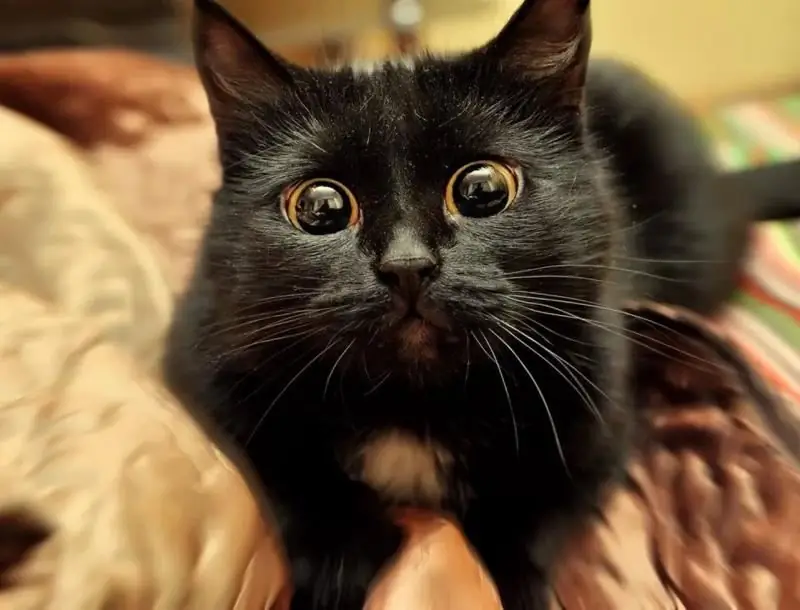
Table of contents:
- Otodectosis: how to save cat ears
- What does ear mite look like in cats?
- How does ear mite infestation in cats?
- Otodectosis symptoms
- Diagnosis of otodectosis
- Otodectosis treatment
- Why is an integrated approach to pet treatment important?
- Possible complications of otodectosis
- Otodectosis in kittens
- Treatment of otodectosis in pregnant cats
- Prevention of otodectosis
- Testimonials from cat owners about the treatment of otodectosis
- Author Bailey Albertson [email protected].
- Public 2024-01-17 22:26.
- Last modified 2025-06-01 07:32.
Otodectosis: how to save cat ears

Otodectosis is the most common cause of otitis media in cats and is highly contagious. If you notice discharge in your pet's ears, the first step is to exclude ear mite infestation.
Content
-
1 What an ear mite looks like in cats
- 1.1 Species and life cycle stages
- 1.2 Can you see it with the naked eye
- 1.3 Most active times
- 1.4 Danger to humans
- How does ear mite infestation in cats?
-
3 Symptoms of otodectosis
3.1 Photo gallery: symptoms of otodectosis
- 4 Diagnosis of otodectosis
-
5 Treatment of otodectosis
- 5.1 Drug therapy for otodectosis
- 5.2 Photo gallery: medicines for the treatment of otodectosis
- 5.3 Table: medicines used to treat otodectosis
- 5.4 Video: Otodectosis in Pets
- 5.5 Traditional medicines in the treatment of otodectosis
- 5.6 How to clean your cat's ears properly
-
6 Why is an integrated approach to pet treatment important?
6.1 Video: Treatment of Otodectosis in Pets
- 7 Possible complications of otodectosis
- 8 Otodectosis in kittens
- 9 Treatment of otodectosis in pregnant cats
- 10 Prevention of otodectosis
- 11 Testimonials from cat owners on the treatment of otodectosis
What does ear mite look like in cats?
In cats, ear mites cause inflammation of the outer ear (otitis media) of parasitic origin.
Species and stages of the life cycle
The causative agent is the ear mite - Otodectes cynotis, belonging to the group of acariform mites. It has an elliptical body, suckers on non-segmented paws and a gnawing type of mouth apparatus. The tick feeds on the outer layer of the epithelium - the epidermis, as well as tissue fluid. Males have four pairs of paws, while females have a fourth pair underdeveloped. The size of the ear mite is 0.3 to 0.7 mm in length and 0.47 to 0.55 mm in width. Females are slightly larger than males. During her life, each female is able to lay several hundred eggs, maintaining the course of the disease. The average tick development cycle is 21 days:
- After 4 days, a larva emerges from the egg, which after 3-12 days of active feeding becomes a protonymph.
- After molting, the protonymph is transformed into a deutonymph.
- Daytonymph after the next molt becomes the adult form of the parasite - the imago; female ear mites begin to multiply already at the deutonymph stage.

In the developmental cycle, the ear mite goes through the stage of an egg, a larva, two stages of a nymph, before becoming an adult form - an imago
In the environment at room temperature, they can last up to 12 weeks, boiling kills them instantly.
Can you see it with the naked eye?
Given the small size of the pathogen, it is very difficult to see it with the naked eye. In some cases, when mites are large enough, they can be seen by placing infected earwax on black paper. The mites look like very small, whitish dots, about half the size of a semolina, spreading over the paper. It will not be possible to identify the pathogen in this way, therefore the diagnosis is made on the basis of laboratory research methods.
Most active time
The ear mite is active all-season, but infection of cats in the summer is somewhat more frequent. Apparently, this is due to the fact that in summer the pathogen is able to persist longer in the external environment.
Danger to humans
Ear mites do not parasitize humans. But in some people, the causative agent of otodectosis, brought from a cat's ears to human skin, can cause an allergic reaction in the form of a rash consisting of papules (bumps), accompanied by redness and itching of the skin. Being on human skin, the pathogen quickly dies and does not carry the danger of infection.

The ear mite has an oval body shape and a gnawing mouth apparatus
How does ear mite infestation in cats?
The reservoir of otodectosis are cats and dogs infected with it, mostly neglected. Among pets, rabbits and ferrets can be infected with otodectosis.
Infection of cats with ear mites occurs:
- in direct contact with a sick animal, especially in free-range cats;
- in some cases, fleas become carriers of ear mite eggs;
-
with crowded keeping cats, infection through common care items is possible:
- litter;
- toys;
- grooming tools;
- carrying bags;
- ticks can be transferred from an infected pet to a healthy pet by the owner.
The disease is highly contagious and affects cats of all ages. The most susceptible are young pets aged 1.5 to 6 months.

Infection of pets most often occurs through contact with sick neglected relatives
Otodectosis symptoms
Otodectosis in most cases affects the inner surface of the auricle, the external auditory canal and the eardrum. A small number of mites can be found on other parts of the pet's body:
- on the neck;
- in the region of the sacrum;
- on the tail.
The spread of the pathogen occurs when the cat sleeps, curled up in a ball.
Symptoms of otodectosis include:
- finding a large amount of earwax of a brown, brown or almost black color in the external auditory canal, outwardly very similar to ground coffee;
- combs on the ears of the cat;
- anxiety of the animal;
- itching in the area of the infected ear, the cat scratches the ear with its paws, and also tries to scratch it on the surrounding objects;
- the presence, in addition to brown sulfur, of discharge from the ears, the nature of which changes from serous at the onset of the disease to purulent during its further development. Otodectosis is complicated by the addition of bacterial or fungal flora. The discharge gives the earwax a putty consistency. Ear mites die in the acidic environment of inflammatory exudate, making it difficult to detect live mites by microscopy. At the same time, the skin itching decreases, but the symptoms of inflammation increase and the cat's condition worsens;
- the presence of scabs in and around the affected ear;
- gradual hearing loss, possible loss of hearing;
- possible fever;
- tilting the head down with the affected ear - this indicates the spread of the process to the eardrum, middle and inner ear;
- seizures - occur with advanced disease, when the process spreads to the meninges.
Photo gallery: symptoms of otodectosis
-

Ear of a cat with otodecosis - With otodecosis, discharge and inflammatory exudate accumulate in the external auditory canal; skin can be damaged by scratching
-

Ear discharge with otodecosis - With otodecosis, discharge from the ears is profuse, dark in color.
-

Wound surface behind the cat's ear - Trying to get rid of severe itching, the cat intensively scratches the ears, which leads to skin damage
Diagnosis of otodectosis
To establish a diagnosis, the veterinarian examines the cat and asks the owner about the onset and development of the disease. Additional research methods are being carried out to verify the diagnosis, and, if necessary, to clarify the extent of the spread of the process:
- microscopy of earwax and ear scrapings are performed. Under the microscope, live mites are visible at different stages of development, and you can also determine the type of secondary flora that has joined;
- bacteriological examination - if necessary, crops are grown on nutrient media for accurate identification of the secondary flora;
- otoscopy - performed to assess the condition of the external auditory canal and tympanic membrane. With severe inflammation of the external auditory canal, refrain from otoscopy until the inflammation decreases;
- computed or magnetic resonance imaging - is performed when the infectious process spreads to the middle, inner ear, meninges.

For a more accurate assessment of the distal ear canal, as well as the tympanic membrane, veterinarians perform an otoscopy
Otodectosis treatment
In the overwhelming majority of cases, treatment of otodectosis is carried out at home, with the exception of those situations when the inner ear and meninges are affected, in these cases, surgical treatment is carried out in a hospital setting.
When treating otodectosis, they are guided by the following principles:
-
treating secondary bacterial or fungal inflammation to reduce pain and itching. For this purpose, apply:
- antibacterial agents;
- antifungal drugs;
- anti-inflammatory drugs;
-
ear cleaning:
- reduces the number of ear mites and secondary microbial flora;
- improves ventilation of the skin of the external auditory canal;
- promotes healing of skin lesions;
- facilitates the action of drugs;
- the use of acaricidal preparations to eliminate ticks. Acaricidal drugs are used directly in the ears in the form of drops, ointments, aerosols; and also be sure to use acaricidal drops on the withers, given the fact that parasites can be found on other parts of the cat's body;
- maintaining the function of the immune system, taking immunomodulators;
- prevention of self-injury of a cat, use of a protective collar;
- treatment continues until the symptoms disappear completely, as well as two successive studies of the ear contents, confirming the absence of ticks;
- prevention of re-infection of the pet, as well as infection of other pets.

Only a veterinarian can prescribe drugs for the treatment of otodectosis.
Drug therapy for otodectosis
For drug treatment of otodectosis used:
-
acaricidal drugs:
-
ear drops:
- Amitrazine;
- Aurikan;
- Neostomosan;
- Tsipam;
- Surolan.
-
gels and ointments for injecting into the ears:
- Ivermek gel;
- Oridermil gel;
- Amidel gel;
- Aversectin ointment.
- aerosols - Acaromectin;
-
drops on the withers:
- Frontline;
- Stronghold.
-
systemic action - used for severe otodectosis:
- Aversect;
- Otodectin.
-
-
antibacterial drugs - antibacterial drugs of a wide spectrum of action are used, in advanced cases, preference is given to drugs of the tetracycline series:
- Sinulox;
- Ciprofloxacin;
- Doxycycline.
-
antifungal drugs - for complications of otodectosis with fungal otitis media:
- Clotrimazole ointment;
- Econazole ointment;
- Tolnaftate (1% solution).
-
antihistamines - used if the cat's otodectosis is complicated by allergic dermatitis:
- Suprastin;
- Tavegil.
-
immunomodulators - used to improve the immune response:
- Gamavite;
- Fosprenil.
-
drugs that improve metabolism - are prescribed for a complicated course of otodectosis:
- Catosal;
- Butazal 100.
Photo gallery: medicines for the treatment of otodectosis
-

Amidel gel - Amidel-gel has, in addition to acaricidal, also an analgesic effect
-

Stronghold - Stronghold drops are applied to the skin of the withers; in order for it to work, it is not necessary to clean the ear, which is important in case of severe inflammation of the external auditory canal
-

Aurikan - Aurican drops have acaricidal, analgesic, anti-inflammatory and antiseptic effects
Table: medicines used to treat otodectosis
| A drug | Structure | Operating principle | Price, rub |
| Doxycycline | Doxycycline | An antibacterial drug of a wide spectrum of action, prescribed for complicated forms of otodectosis. Not suitable for pregnant and lactating cats; in kittens during the period of changing teeth; with decompensation of liver and kidney function, in malnourished pets | from 23 |
| Stronghold | Selamectin | Drops for application to the skin. They have anthelmintic, acaricidal, insecticidal effects. If necessary, re-processing is carried out in a month. It is not used in kittens under 6 weeks old, as well as in sick and weakened animals. Not injected directly into the ear canal. Can be used in pregnant cats | from 285 per pipette |
| Frontline Spot-on | Fipronil | Drops for application to the skin. They have insecticidal and acaricidal effects. 4-6 drops are instilled into each ear, the rest of the product is applied to the skin between the shoulder blades. After 3 weeks, the treatment is repeated. You can not wash the cat within 2 days after treatment. Approved for use in pregnant and lactating cats. Does not apply to kittens up to 2 months old - use Frontline spray for very small kittens | from 370 |
| Amidel-gel Neo |
|
Topical gel. It has acaricidal action, lidocaine reduces pain, chloramphenicol is an antiseptic. The product is evenly applied to the affected areas after cleansing with the capture of healthy skin by 1 cm. The drug is used from 2 to 5 times with an interval of 5-7 days. Not suitable for pregnant cats and kittens up to 4 weeks old | 195 |
| Aurikan |
|
Ear drops. They have acaricidal, antiseptic, anti-inflammatory and analgesic effects. The drug is instilled in 5 drops into each ear once a day for a week, then twice a week for a month. Data on use in kittens and pregnant cats are not provided in the instructions | 579 |
| Otodectin | Ivermectin | Solution for subcutaneous injection. It has acaricidal, anthelmintic and insecticidal effects. It is applied twice with an interval of 10 days. Not applicable to kittens under two months of age; there is no data on use in pregnant cats in the instructions | 621 |
| Tavegil | Clemastine | An antihistamine used to eliminate the symptoms of allergic dermatitis, which can cause otodectosis. Not applicable in pregnant cats | from 159 |
Video: otodectosis in pets
Traditional medicine in the treatment of otodectosis
Traditional medicines are significantly inferior in effectiveness to drugs, and are worthy of attention in cases where help is needed for the cat, and the drugs prescribed by the doctor from the pharmacy have not yet been brought. Modern acaricidal agents can be used in pregnant cats and kittens. In addition, for a complete cure of a cat, it is necessary to exterminate all ticks, including those on other parts of the body, which cannot be achieved using only traditional methods. For the treatment of otodectosis in cats, folk remedies are used:
-
Sulfur and potassium carbonate ointment based on lard:
- Take 20 g of melted lard without salt.
- Add 8 g of potassium carbonate.
- Add 15 g of colloidal sulfur.
- Stir well until a homogeneous ointment is obtained.
- Apply the resulting product to the skin of the external auditory canal and auricle 2-3 times a day until the symptoms disappear completely.
- Infusion of strong green tea - rubbed over the cat's ears to reduce inflammation.
How to clean your cat's ears
In advanced cases of otodectosis, inflammation in the ears can be so strong that at the slightest touch to the skin of the ear, damage to the inflamed epithelium and the formation of a sedimentary surface occurs. The cat behaves aggressively, cleaning the ears is painful for her. Therefore, the ears are not cleaned in such cases. Treatment begins with acaricidal drugs such as Stronghold or Frontline, which are applied to the skin of the withers; also use antibacterial agents, for example, Sinulox, in tablets or injections. These funds realize their effect, acting systemically, and they return to cleaning the ears and the use of drugs for local therapy when the inflammation decreases and cleaning the ears will not result in additional trauma to the inflamed skin and suffering of the cat.
Even if the cat before the illness calmly tolerated cleaning the ears, she will resist when trying to clean the sore ears. In order to clean the cat's ears, it is better to swaddle it with a towel and use the help of an assistant who will hold the cat. In the absence of an assistant:
- Prepare all necessary ear cleaning products and wipes and place them nearby.
- Swaddling the cat with a towel and putting it on your lap will make it easier to restrict its mobility using your elbows and body.
- Open the cat's ear and assess the condition of the skin of the inner surface of the auricle and the visible part of the external auditory canal.
- Wipe the inside of the auricle and the visible part of the external auditory canal with a napkin moistened with hygienic ear lotion or an aqueous solution of chlorhexidine.
- After cleaning the skin, remove excess lotion or antiseptic with a dry napkin.
-
Depending on the prescribed agent, they carry out:
- instillation of drops;
- applying a gel or ointment, they are spread over the surface of the ear with a napkin;
- aerosol spraying.
- The cat's ear is folded in half and gently massaged at the base, contributing to an even distribution of the drug.
- Wipe with a napkin soaked in this preparation, the outer surface of the ear and the areas of wool around it.
- Repeat all the above steps with the other ear, even if it looks healthy. Use different wipes to prevent tick transfer.
- Put on a protective collar on the cat to prevent self-harm and release it.
- Collect all used, mite-soiled napkins, put them in a plastic bag, tie them tightly and discard. If possible, it is better to burn it.
Ear cleaning with otodectosis is carried out 2 times a day, with the signs of inflammation subsiding - daily, until complete recovery.

In order to protect yourself from the claws of the cat, as well as limit its mobility, before cleaning the ears of the pet, you need to swaddle with a towel
Why is an integrated approach to pet treatment important?
The implementation of all measures prescribed by the veterinarian is necessary to achieve the fastest recovery time, as well as to prevent re-infection. It is extremely important to combine local acaricidal agents with agents applied to the withers in the form of drops, because if you do not destroy all the ticks, the disease will return. The use of antibacterial and antifungal drugs is important because the accompanying bacterial or fungal otitis media poses a health risk to the cat. Desensitizing agents prescribed by a veterinarian are effective in controlling the allergic inflammation that otodectosis causes in some cats and preventing the development of associated complications. The recovery of pets with an advanced form of the disease, as well as elderly and weakened cats, can accelerate immunomodulators and drugs,improving metabolism.
Video: treatment of otodectosis in pets
Possible complications of otodectosis
Complications of otodectosis include:
- bacterial or fungal otitis media - are the most common complications of otodectosis;
- hematomas and lymphoextravasates of the auricle are also common, are the result of self-harm and require the participation of a veterinarian. Hematomas are formed when a blood vessel is damaged, lymphoextravasates are formed when a lymphatic vessel is damaged by the claws of a cat. In this case, an accumulation of blood or lymph occurs in the tissues of the ear, which requires the opening and drainage of the formed cavity with the evacuation of its contents. Otherwise, suppuration will occur, which will result in persistent cicatricial deformity of the ear. Opening and drainage of a hematoma or lymphoextravasate is performed by a veterinarian;
- miliary dermatitis (eczema) - develops in some cats because the saliva and feces of mites are strong allergens. At the same time, numerous bubbles appear in the ears, which, opening, turn into erosion, covered with dry crusts. This increases the inflammation, pain and itching of the skin, significantly worsening the condition of the cat;
-
perforation of the tympanic membrane and the development of otitis media and internal otitis media:
- leads to a decrease in hearing, up to its complete loss, but with a small hole size and full treatment, the membrane quickly recovers;
-
leads to the appearance of peripheral vestibulopathy, while:
- coordination of movements in a cat is impaired;
- a lateral tilt of the head is characteristic, the affected ear is turned downward;
- the cat can move in a circle;
- nausea may occur when moving;
- squint occurs.
-
with the further spread of the infection with an extremely severe type of the course of the disease, it is possible to develop intracranial complications - meningitis and brain abscess, which manifest themselves:
- extremely serious condition of the cat;
- high fever;
- convulsions;
- coma and death.

Ear hematoma often occurs with otodectosis as a result of self-injury; opening and emptying of hematomas is carried out by a doctor in a veterinary clinic
Otodectosis in kittens
Kittens are very susceptible to otodectosis, therefore, they need regular monitoring of the condition of the ears and timely referral to the veterinarian if there is a suspicion of developing otodectosis. The treatment of kittens is guided by the principles applicable to the treatment of adult cats, using medication, taking into account the restrictions associated with the kitten's age.
Kittens up to 4 months old may have an extremely difficult atypical form of otodectosis, which manifests itself:
- the kitten shakes its head;
- seizures occur, including prolonged (up to 10 minutes);
- the onset of sudden death.
Treatment of otodectosis in pregnant cats
In the treatment of otodectosis in pregnant cats, Stronghold or Frontline is used in the form of drops on the withers; the choice of antibiotic therapy is difficult, but in advanced cases with middle and internal otitis media, antibiotic therapy is necessary for health reasons. It is important to identify and treat feline otodectosis in the early stages, before developing bacterial or fungal otitis media, so as not to use antibiotics.
Prevention of otodectosis
Measures for the prevention of otodectosis:
- preventive treatment with acaricidal drugs, which are often included in the composition of drugs that prevent the appearance of fleas;
- prevention of contact of cats with stray animals;
- regular monitoring of the condition of the cat's ears;
- when introducing a new pet, especially one taken from the street, into an established feline collective, it is necessary to make sure that it does not have otodectosis;
- regular wet cleaning of the room in which cats are kept;
- steam treatment of couches and soft toys, regular washing of bedding;
- avoiding crowding when keeping cats.
If one of the cats living in the house is sick with otodectosis, then all pets should be treated, since otodectosis is a highly contagious disease
Testimonials from cat owners about the treatment of otodectosis
The ear mite is the causative agent of otodectosis in cats, which is very often complicated by otitis media, as well as ear injuries that the cat inflicts on itself when combing. Also, allergic dermatitis can become a complication of otodectosis. With an unfavorable development of the disease, severe complications may develop with the involvement of the middle and inner ear, meninges and brain. Therefore, the treatment of otodectosis in a cat should be given the utmost attention; remedies for the treatment of the disease are presented in a wide range, and the veterinarian has the opportunity to make the most appropriate choice for each pet.
Recommended:
Cystitis In Cats And Cats: Symptoms (blood In Urine And Others) And Treatment At Home, Medications (pills And Others), Veterinarian Advice

What causes cystitis, its symptoms, course forms, diagnosis, treatment. Caring for a sick cat, prevention of cystitis
Renal Failure In Cats And Cats: Symptoms, Treatment, How To Save A Kitten And An Adult Animal (recommendations Of Veterinarians)

Types of renal failure in cats The reasons for its development. How pathology manifests itself and is diagnosed. Inpatient and home treatment. Prevention
Flea Dermatitis In Cats: Symptoms (description And Photo), Diagnosis Of The Disease, Its Treatment At Home, Prevention

Features of fleas, the reasons for the development of flea dermatitis. How it develops, symptoms, how to diagnose and treat. Danger to people
Diseases Of The Eyes In Cats: Photos Of Symptoms, Diagnosis And Treatment (including At Home), Recommendations Of Veterinarians

What eye diseases are found in cats? How do they manifest. Treatment rules. Animal care during therapy. Prevention. Veterinarian recommendations
Red Gums In Cats (including Gingivitis): Symptoms, Photos Of Redness Around The Teeth, Diagnosis And Treatment At Home

What do red gums look like in a cat? What conditions may be a symptom of redness. Types of gingivitis and their causes. How to treat pathology. Prevention
